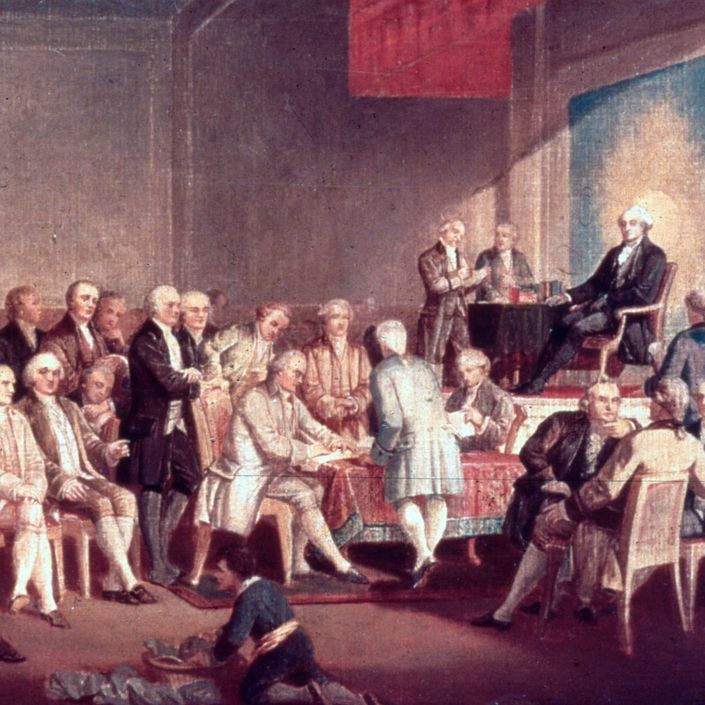
Originalist Papers, Part I
September 1787 - December 1787
When Donald Trump nominated Amy Coney Barrett for the Supreme Court, the progressive left went ballistic that he selected an "originalist" justice to replace the most progressive member of the Court, Ruth Bader Ginsburg. I would surmise that most leftists could not define "originalism" if asked, nor could most "conservatives." This is troubling. Originalism is based on the principle that the Constitution should be interpreted the way the founding generation insisted it would be interpreted at the time of ratification, not one hundred or two hundred years after some other justices on the Supreme Court wrapped their paws around it with dubious decisions.
This four part course is designed to make you familiar with the 100 most important public documents that favored ratification in 1787 and 1788, or in other words the real basis of originalism. Some of the Federalist Papers are included in the course, but you'll also hear from other important--perhaps more important than Hamilton, Madison, or Jay--members of the founding generation who supported ratificaiton and why. Several themes become apparent when going through this stack of speeches, pamphlets, and essays, but the most important is the primacy of the States in the system and the limited powers of the general government. There is some deviation to this narrative, even from men like Hamilton, but most agreed the Constitution was so limited in its delegated powers that other than commerce and defense, the people of the States would rarely notice the general government.
Part I of the course covers twenty five documents from Oct 1787 to Dec 1787 and is in chronological order. Parts II, III, and IV will follow the same format.
All essays covered in the lectures are included with an edited introduction for each selection.
Your Instructor
Brion McClanahan holds a Ph.D in American History from the University of South Carolina. He is the author or co-author of six books, including the #1 Amazon best selling 9 Presidents Who Screwed Up America and How Alexander Hamilton Screwed Up America.
Course Curriculum
-
StartA Jerseyman: To the Citizens of New Jersey, November 6, 1787 (27:17)
-
StartPelatiah Webster: A Citizen of Philadelphia: The Weaknesses of Brutus Exposed, November 8, 1787 (37:02)
-
StartAlexander Hamilton: Federalist No. 7, November 17, 1787 (25:45)
-
StartAlexander Hamilton: Federalist No. 8, November 20, 1787 (22:28)
-
StartAlexander Hamilton: Federalist No. 9, November 21, 1787 (19:40)
-
StartRoger Sherman: A Countryman II, November 22, 1787 (15:40)
-
StartJames Madison: Federalist No. 10, November 22, 1787 (30:20)
-
StartJames Wilson: Speech Before the Pennsylvania Ratifying Convention, November 26, 1787 (50:41)
-
StartOliver Ellsworth: A Landholder IV, November 26, 1787 (17:55)
-
StartJames Madison: Federalist No. 14, November 30, 1787 (19:38)
-
StartAlexander Hamilton: Federalist No. 15, December 1, 1787 (26:34)
-
StartOliver Ellsworth: A Landholder V, December 3, 1787 (19:06)
-
StartAlexander Hamilton: Federalist No. 16, December 4, 1787 (19:01)
-
StartJames Wilson: Speech Before the Pennsylvania Ratifying Convention, December 4, 1787 (41:38)
-
StartOliver Ellsworth: A Landholder VI, December 10, 1787 (18:50)
-
StartThomas McKean: Speech in the Pennsylvania Ratifying Convention, December 10, 1787 (39:09)
-
StartAlexander Hamilton: Federalist No. 22, December 14, 1787 (27:46)
-
StartOliver Ellsworth: A Landholder VII, December 17, 1787 (13:04)
-
StartAlexander Hamilton: Federalist No. 23, December 18, 1787 (19:23)
-
StartAlexander Hamilton: Federalist No. 24, December 19, 1787 (19:28)
-
StartNew Jersey Journal: Reply to George Mason’s Objections to the Constitution December 19, 26, 1787 (25:43)
-
StartAlexander Hamilton: Federalist No. 28, December 26, 1787 (15:32)
